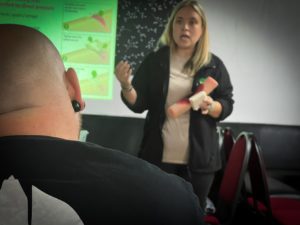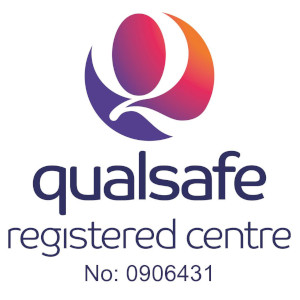How first aid and blood donation work hand-in-hand to save lives
Every second counts in a medical emergency. Whether it’s a road traffic accident, a workplace injury, or a sudden fall at home, severe bleeding can be life-threatening in minutes.
That’s where first aid comes in; your quick actions to control bleeding can keep someone alive long enough to receive the help they need; Stop the Bleed and Save a Life. But what many people don’t realise is that blood donors also play a crucial role in this life-saving chain.
As we recognise World Blood Donor Day 14th June, it’s the perfect time to highlight how first aid skills and blood donations work together to save lives and why we need both.
The Power of First Aid
In any emergency involving bleeding, the first few minutes are crucial. Knowing what to do and having the confidence to do it, can mean the difference between life and death.
That’s where first aid comes in. When someone is seriously bleeding, immediate action is essential to slow or stop the blood loss until professional medical help arrives. First aid training equips you with the knowledge to assess the situation, stay calm under pressure, and apply the right techniques.
By using basic but effective methods such as:
-
Applying firm pressure to the wound,
-
Raising the injured area above heart level where appropriate, and
-
Using sterile dressings or clean cloths to protect the injury,
you can significantly reduce blood loss and give someone the best possible chance of survival.
Early intervention doesn’t just save lives, it also reduces the severity of injuries and improves recovery outcomes. In short, the more people trained in first aid, the safer our homes, workplaces, and communities become.
When First Aid Isn’t Enough
While first aid is critical in stopping or slowing down bleeding, there are times when it’s not enough on its own. In cases of severe trauma, internal injuries, or major accidents, the body may lose a dangerous amount of blood quickly and no amount of external pressure can replace what’s been lost.
As first aiders we can then use tourniquets to help stop the bleed. Read our blog here to learn more on severe bleeding.
That’s when medical teams rely on blood transfusions to save lives.
Every day, hospitals across the UK treat patients who need donated blood urgently due to:
-
Road traffic collisions
-
Workplace accidents
-
Complicated childbirth
-
Emergency surgeries
-
Serious medical conditions like anaemia, cancer, or blood disorders
These situations all have one thing in common, they require a safe and steady supply of donated blood.
Unfortunately, blood can’t be manufactured or stockpiled for long periods. It depends entirely on the generosity of volunteer donors who give regularly. Without those donations, hospitals wouldn’t be able to carry out many of the life-saving procedures they do every single day.
So while first aid helps stabilise a person at the scene, blood donations are often the next step in their survival journey.
The Link Between Action and Supply
When someone suffers severe blood loss, survival depends on a chain of critical actions and each link in that chain plays a vital role.
It begins with the first aider: the person who acts quickly to stop or slow the bleeding. This early response buys valuable time and prevents the situation from worsening.
Next comes the emergency services, who provide advanced care and rapid transport to hospital. But even with swift medical intervention, some patients arrive at hospital in need of immediate blood transfusions.
That’s where the final link; the blood donor comes in.
Without enough donated blood available, hospitals simply can’t perform life-saving transfusions. Trauma patients may require multiple units of blood within minutes of arrival. For them, survival is only possible because someone, somewhere, took the time to donate.
In other words, first aid and blood donation are two sides of the same life-saving coin.
Whether you’re the one giving aid at the scene or the one giving blood in a clinic, your actions matter. They’re part of a shared responsibility that keeps our communities safer and stronger in the face of emergencies.
What You Can Do
Emergencies can happen anytime, anywhere — and being prepared could save a life. Whether you’re at home, at work, or in the community, there are two powerful ways you can make a difference:
1. Get Trained in First Aid
Learning how to manage bleeding and other emergencies gives you the confidence to step in when it matters most. First aid training equips you with the practical skills to protect others and potentially save lives. It’s not just a box-tick — it’s a vital life skill.
Book a course with us today and be ready to act when every second counts.
[Insert link to manual handling or first aid training page]
2. Donate Blood – or Encourage Others To
If you’re eligible, giving blood is one of the simplest, most generous acts you can do. Every donation helps someone in need — whether it’s an accident victim, a cancer patient, or someone undergoing surgery.
Not everyone can give blood, but everyone can encourage friends, family, or colleagues to donate. You never know whose life they might save.
Visit NHS Giving Blood to find your nearest donation centre.
Together, first aiders and blood donors form the frontline of emergency care.
This World Blood Donor Day, take a step that could save a life.
Further Training – Stop the Bleed Save a Life
We offer a range of first aid courses for all ages from workplaces to education. On our emergency first aid courses we can teach more in-depth about catastrophic bleeding. Furthermore, we can create bespoke first aid courses including catastrophic bleeding as the main topic for your session
teach more in-depth about catastrophic bleeding. Furthermore, we can create bespoke first aid courses including catastrophic bleeding as the main topic for your session
Our current first aid courses;
- Emergency First Aid at Work
- First Aid at Work
- Emergency Paediatric – one day
- Paediatric – two day
- Parents’ first aid – 2-3 hours
- Children’s first aid – 2 hours – ages 8 plus
Our Emergency and First Aid at Work courses are for those working in an office, factory, warehouse, manufacturing or on a building site. These courses will set you up to know exactly what to do in an emergency. Completing our courses will help you understand the hazards and risks in your workplace to therefore prevent accidents.
Apprentices, staff who are unlikely to be left alone with children, and lunchtime supervisors are all candidates for our Emergency Paediatric First Aid Training. Our one-day course includes roles and responsibilities of a first aider, first aid kits, accident reporting, reasons of a life-threatening condition, CPR, defibrillator, causes of unconsciousness and recovery position, choking, bleeding, burns, and minor injuries.
Our Paediatric First Aid Training 2-day course includes all elements of the one-day first course including; broken bones, spinal injuries, head injuries, slings, sprains and strains, diabetes, febrile convulsions, hypothermia, hyperthermia, epilepsy, poisons, eye injuries, allergies and anaphylaxis, and asthma.
This course is ideal for those working alone with children, whether you are a Teacher or Teaching Assistant working in the Early Years or a childminder. Our Paediatric courses are fully accredited. We have open courses running at our Brownhills Centre or we can come to your setting.
Additionally, if you prefer to have a short session with us and complete a bespoke parents/grandparents course; our Parent’s first aid course is for you. These start from 2 hours up to 4 hours. Can include any modules of your choice, but we will cover: reasons of life-threatening conditions, CPR, Defibrillator, unconsciousness, recovery, choking and gagging, burns, and minor illnesses, including dangers within the home.
Our courses provide you with the peace of mind that you’ll know what to do in the event of an emergency, such as illnesses like asthma. Furthermore, getting first aid training will give you the skill set of knowing exactly what to do if your child, friend, or work colleague suffers from an injury or life threatening condition. Never put yourself in a situation where you’re thinking, “What if I knew what to do?” Get First Aid Trained Today!
If you have any questions with this blog we are happy to help. It is important to know what to do in an emergency if you have a severe bleeding injury. If you want to know how, our Emergency First Aid at Work Course, is the course for you. Here is the link to our upcoming courses. https://www.hmbtrainingservices.co.uk/courses
For further enquires please call us on: 01543 453338 or email on info@hmbtrainingservices.co.uk



